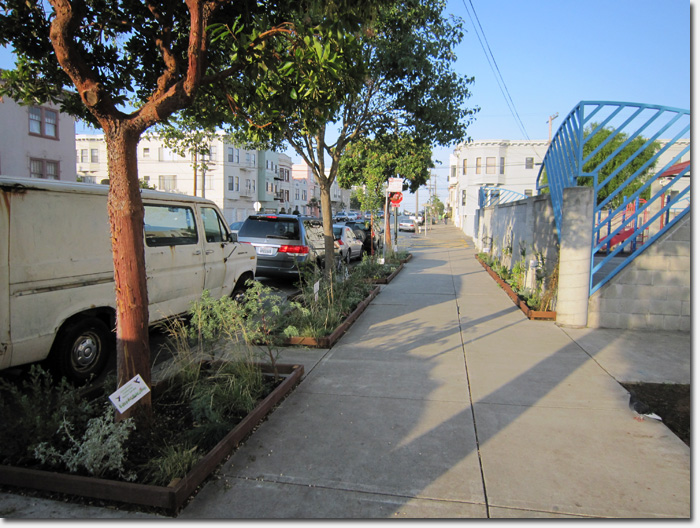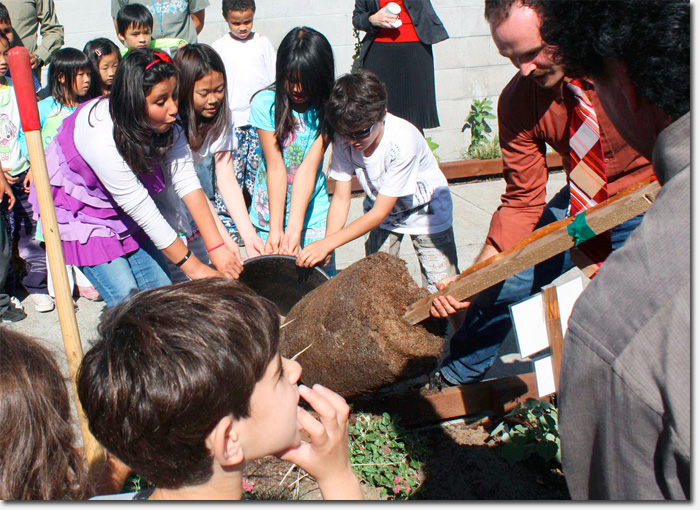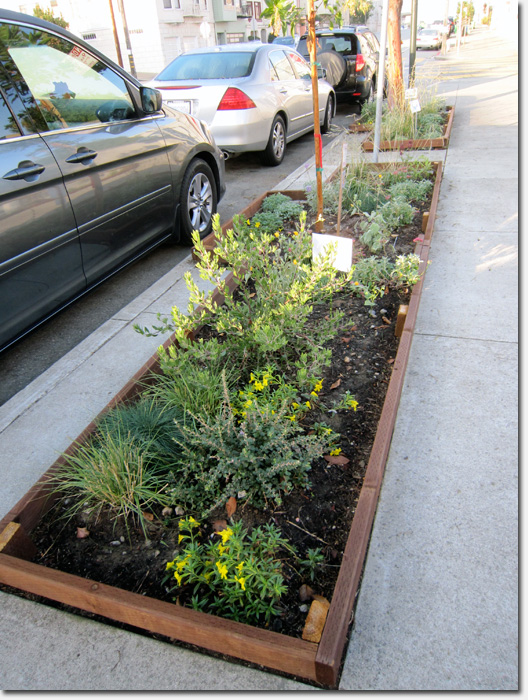
Last week, the students at Argonne Elementary School at 18th & Cabrillo got a lesson in how to beautify their campus. Step 1: remove some of the concrete and replace it with a garden.
For the past 10 years, Argonne students have been visiting the Children’s Garden at the San Francisco Botanical Garden as part of their Youth Education Program. From that came a desire for Argonne to start its own garden on campus.
Then in February 2011, the Botanical Garden announced a new program called “Grey 2 Green”, designed to teach residents how to transform their sidewalks into attractive, landscaped areas. “Less concrete. More jungle.” is the program’s theme, which is a joint venture with the Department of Public Works.
Argonne School was selected to pilot the program and after 3 months of work, 240 square feet of sidewalk along Cabrillo near 18th Avenue was converted into a garden with 15 varieties of California Native plants, as well as bee and butterfly habitats.
The garden celebrated its grand opening last Friday which included a ceremonial planting of a Strawberry Tree (Arbutus Marina) by the students.

“Our school community has been transformed by this partnership with Grey2Green,” said Tina Eshaghpour, Parent Teacher Organization (PTO) Green Argonne Chair.
“We have seen concrete sidewalk, where people dump trash, transformed into a learning and community meeting place, where students delight in the butterflies that visit and neighbors pause to give us a smile and express appreciation for making our street more beautiful.”
Interested in transforming some of the grey outside your home into green? The Grey 2 Green program is still underway. Around 250 residents have attended the workshops so far this year, and the final one for 2011 will be held on Saturday, November 12 at the Botanical Garden in Golden Gate Park from 9am until 10am.
Sarah B.

Great little garden; I walk by it on the way to the store. Granted, there should be more garden within the schoolyard (say one nice grove, rather than individual, widely-spaced trees), but this is a start. Grandkids live in the Mission where corner and curbside plantings such as this have really transformed that neighborhood.
If, like me, you rent an upstairs flat and would like to engage in LARGE-scale gardening (rather than just admire what the neighbors plant in their backyards), there are numerous ways to volunteer — Mt. Sutro trails and habitat on 1st Saturdays (www.sutrostewards.org), GG Park Oak Woodlands on 2nd Saturdays (http://www.facebook.com/groups/314762315016/) and GGNRA’s native plant nurseries. The more you work with native plants, the more you’ll see.
Greening the sidewalks is beautiful. Does anyone else think it’s ironic that the SF Botanical Garden, which is partnered with SF Rec & Parks, sponsors Grey2Green, while at the same time Rec & Parks is pushing hard to replace over 7 acres of natural turf in Golden Gate Park with artificial turf soccer fields? (www.sfoceanedge.org)
Looks great. Funny, but I think the edging isn’t ADA compliant (per what I learned at the workshop I attended) – it needs to be set back more. But, details, shmetails, it looks great kids! Now, I must get my own little bit of Grey2Green growing… gotta file permits and pay $$$, which is the first hurdle.
ahh, so cute, those little sidewalk gardens! whatever, they don’t really cut it. what san francisco needs is a massive tree planting program. s.f. is one of the ungreenest city one can imagine. yes, we have the confined greeneries such as golden gate park. but besides that s.f. is fading away in comparison with los angeles (what? gasp!!), NYC, etc.
treeplanting should be obligatory for all building owners. let’s say one tree per 50′ street front. and tree means not shrubbery or bonsais, but trees which reach 40′-50′ height and and canopy diameter.
it almost seems like san franciscan hate trees. symbolic are the stunted sycamores (?) east of city hall. regularly cut back so that they stay crippled and don’t become actual trees… (actually that is another one of the city’s many follies: they didn’t have enough money/ground depth after building the underground facilities for more than i think 2′-3′ of dirt, so the thin layer cannot support bigger trees. or so i heard…)